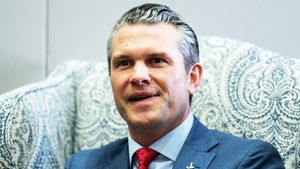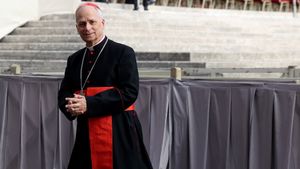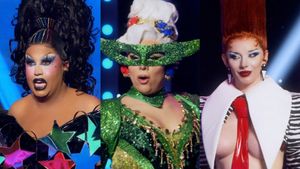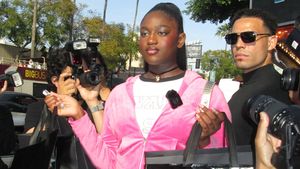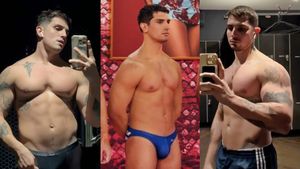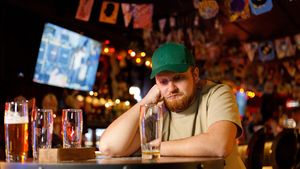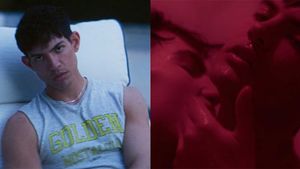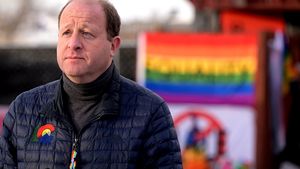The 2012 London Summer Olympics begin July 27th.
While we all know that homophobia in sports is the other "Don't Ask, Don't Tell," 21 openly LGBTQ athletes, two coaches and two gay paralympians will compete for the gold. Three LGBTQ olympians will represent the US - Seimone Augustus (basketball), Megan Rapinoe (soccer), and Lisa Raymond (doubles tennis).
Lesbian U.S. wrestler Stephany Lee qualified for London but was kicked off the team after testing positive for marijuana. And with women's softball no longer an Olympic sport (remember those hotties!), the number of out lesbians is lower.
Of the 12,602 Olympians in this year's games, less than 10% (126) are openly lesbian, gay, bisexual, transgender and queer (LGBTQ). But London's numbers are twice those of Beijing’s in 2008.
Being an LGBTQ Olympian doesn’t elicit as much homophobic shock and awe as it did when four times American Olympic gold medalist Greg Louganis competed in the 80s. But homophobia finds a way to surface, and now a days its not so much about an athlete's sexual orientation as it is now more about suspecting that a LGBTQ athlete is perpetrating "gender fraud."
Will these London games have their "gender fraud" squad trolling the stadium looking for impostors?
The Beijing Olympics did.
In 2008, Time Magazine listed 100 Olympic athletes to watch out for. Dara Torres, nine-time Olympic medalist, was one of them. At 41, Torres was swimming faster than in her 20s, revealing a more muscular and tone physique. While the question of steroid use could be asked, questions concerning her gender and sexual orientation should not.
The organizers of the Beijing Olympics devised a “gender-determination laboratory” for “suspected” athletes like Torres, to catch “gender frauds” - men masquerading as women.
Their experts at Peking Union Medical College Hospital evaluated each ”suspected” female for “gender verification” based on blood samples to test their genes, hormones, chromosomes and, first and foremost, their external appearance. According to these experts, Torres, with her washboard abs, on appearance alone, should fail.
And while we know reducing female athletes to their sex chromosomes is absurd, America has a different test to verify the authenticity of its “gender frauds” - culture markers of beauty and femininity. And Torres, on appearance alone, failed.
The question of women’s physiques has always suggested a norm of beauty and femininity that “supposedly” many female athletes don’t meet. And their image as strong women has always created fear about a deluge of lesbians, intersexuals and transwomen titling the level playing field in our favor from “real” women.
More on next page...
\\\
(continued)
With the passage of Title IX of the Education Amendment of 1972 prohibiting discrimination based on gender in education programs and activities receiving federal funding, women’s participation in high school and collegiate sports increased. But with women’s increased participation in sports, the damaging stereotype of the lesbian athlete became prominent as a way to police unfeminine behavior. And many women who chose to participate in sports often went to great lengths to display traditional heterosexual cultural markers through their clothing, hairstyles and mannerisms.
LGBTQ athletes must constantly monitor how they are being perceived by teammates, coaches, endorsers and the media in order to avoid suspicion. They are expected to maintain a public silence and decorum so that their identity does not tarnish the rest of the team.
For example, tennis great Martina Navratilova, who is a lesbian, was publicly taunted for not bringing femininity and beauty to her game. Her muscular physique and supposedly masculine appearance killed not only sponsor endorsements but also attempted to kill her spirit in playing the game.
“As a professional tennis player, when I came out, my focus wasn’t on things like losing endorsements or handling the press or even sacrificing personal privacy. The biggest thing on my mind was being true to myself: I realized that I couldn’t go on being a champion on the court if I was leaving half of myself off the court,” Navratilova wrote in the book Crisis: 40 Stories Revealing The Personal, Social, and Religious Pain and Trauma of Growing up Gay in America, published in September 2008.
The question of who is a “real” female and who isn’t will persist as long as lesbian-baiting continues to be part and parcel of the world of sports.
For example, Olympic basketball player Lisa Leslie was perceived to be a “girly-girl,” therefore, not a lesbian, but certainly a weak and non-aggressive player. Tennis phenoms the William Sisters are aggressive players but too muscular, especially Serena, to be seen as feminine.
Sports programs are a particular challenge when attempting to make schools, playgrounds, and locker rooms safe of our LGBTQ children. And as long as young women will be stigmatized as lesbian it will control women’s participation.
But sports can also provide innumerable opportunities to teach valuable life lessons and can be a powerful influence in addressing myriad social issues. Eliminating LGBTQ-baiting can be one of them.
Hopefully, the London Olympics will model an example of it.
Follow SheWired on Facebook.
Follow SheWired on Twitter.









































































